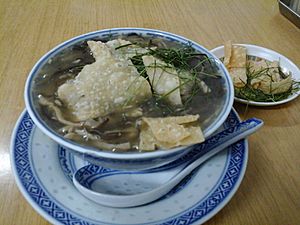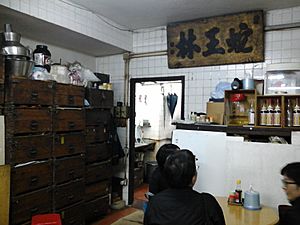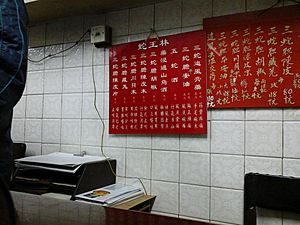Snake soup facts for kids
Snake soup is a special dish from Hong Kong. It's a popular food and is thought to be good for your health. The soup is made with meat from at least two different kinds of snakes. It tastes a little sweet because of things like chrysanthemum leaves and spices. Many people say the snake meat feels and tastes like chicken.
You can usually find snake soup in special shops called "Snake King" or "Shea Wang." These shops are mostly in areas like Shum Shui Po and Kowloon City. People often eat snake soup in the fall or winter.
Snake soup has been around for a very long time, even centuries ago. In Chinese culture, it's believed to have health benefits and be very nutritious. However, these days, there are fewer people making snake soup in Hong Kong. This is because it's hard to find new people to learn how to make it.
Contents
A Look Back in Time
People in China have thought of snake soup as a special food for over two thousand years! Long ago, people in Guangdong province started eating snake soups. This way of eating became very popular across China later on. Snake soup was once seen as a "high-status" meal. This was because it used many different ingredients and took a lot of work to prepare. It was a sign of wealth and respect, and only important people or famous guests would get to eat it.
The first shop in Hong Kong to sell only snake soup was called "Snake King Lam." It opened more than 110 years ago! The snake soup business was at its best in the 1980s. Back then, there were over 100 places that made snake soup. Some shops even had to open new locations because so many people wanted to buy it.
Today, there are only about 20 shops that specialize in snake soup. This is partly because food prices and rent have gone up a lot. Also, it's hard for the people who make snake soup to find new helpers to learn the skills. Not many people want to do this job because it can be hard and sometimes dangerous, as it involves working with snakes that can be venomous.
How Snake Soup is Made
Making snake soup usually involves at least two types of snakes. The snake meat is shredded into thin pieces. Then, it's boiled with other ingredients like chicken, pork bones, lean meat, fish maw, mushrooms, ginger, lemon leaves, and other spices for flavor.
This mixture is cooked for more than six hours to become a thick soup. It's seasoned with salt, pepper, and dark soy sauce to taste. A thickener, like corn starch, is added to make the soup thick and clear, not watery like a broth. Sometimes, more ingredients like pork chops or herbs such as star anise are added to make it even richer.
The types of snakes used can be different depending on the place. Water snakes and pythons are common choices. Other snakes often used include the Chinese cobra, banded krait, and the Indo-Chinese rat snake. At many restaurants, customers can even pick out live snakes to be prepared for their soup!
What Does it Taste Like?
Snake meat is light pink in color. It tastes much richer than fish and is chewier. Some people describe it as tasting like chicken, but a bit tougher.
When you eat snake soup, you might find it has finely cut dark mushrooms, thin strips of chicken, and fragrant chopped ginger. These ingredients, along with other herbs and spices, make the broth very hearty.
Traditionally, snake soup is served with very thin pieces of lemon leaves and chrysanthemum flowers. These help to balance out the saltiness. Nowadays, many people also add pepper, vinegar, and thin, crispy pieces of fried dough. These additions make the soup taste even better and add interesting textures.
Traditional Health Beliefs
In old Chinese medical books, it's believed that snake soup has many health benefits. People thought it could help with body aches, make your blood stronger, improve your skin, and boost your energy levels.
Many Chinese people also believe that snake soup is a "warming" food. This means it helps to heat up your body. This is especially popular during the winter season to help balance the body's "cooling" energy.




